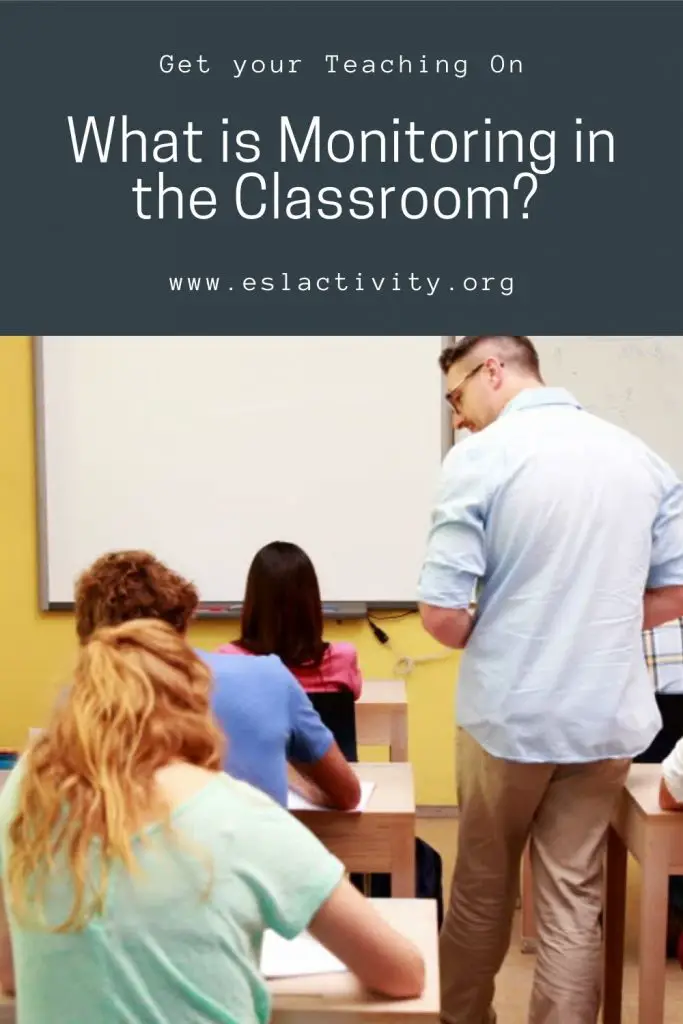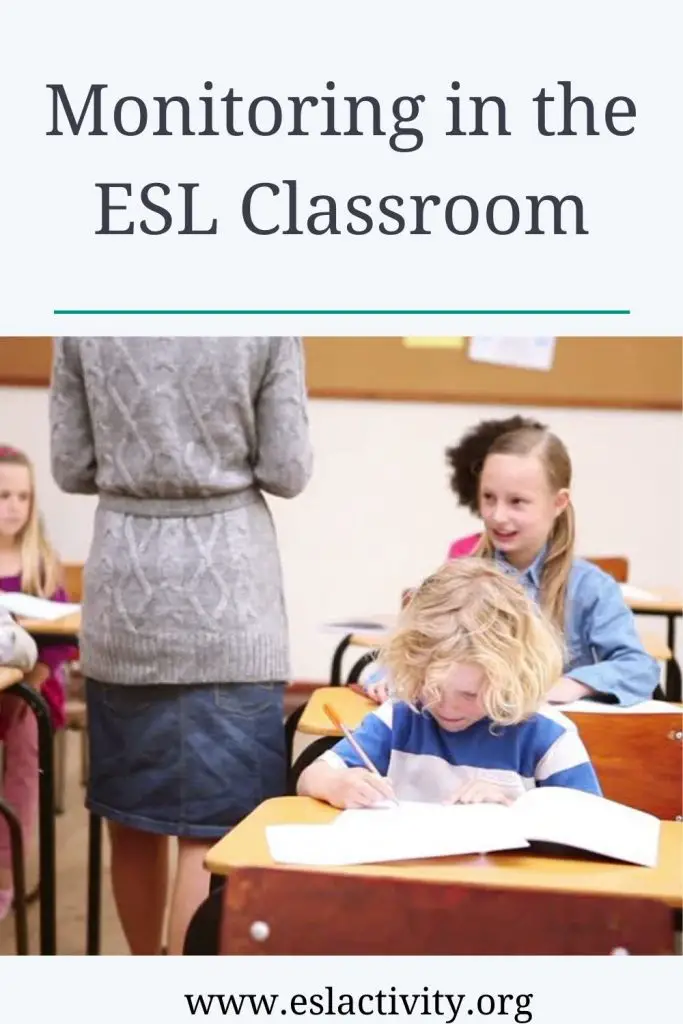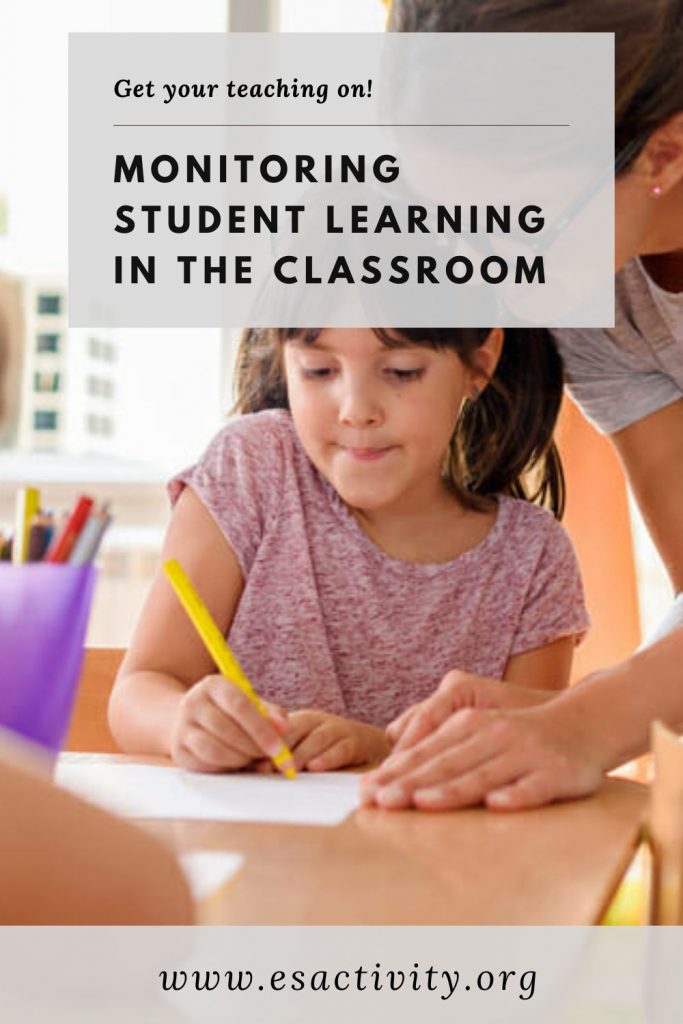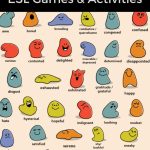Teaching English as a Second Language (ESL) means you have to ensure your students are actually learning something inside the classroom. To evaluate learning, you may conduct tests and exams to check what they learned in your class. However, during class, you may want to do some monitoring to track progress with things like pronunciation, grammar or vocabulary usage. Monitoring student learning in the classroom is a key concept that all teachers should have knowledge of!
Evaluating learning through tests and exams is a type of monitoring activity you would need to perform in your ESL classroom. But, monitoring is not only limited to conducting tests and exams. You can also monitor your classroom in many different ways, including taking a look at language discourse.
Before we go deep into the topic of monitoring, let’s take a look at what ESL monitoring is all about.

What is monitoring in the language classroom?
What is Monitoring in the Classroom?
Monitoring is a set of activities conducted by the teachers to keep track of how the students are performing in class. It is mainly done to facilitate instructional decisions and provide feedback to students about how they are doing in class.
While this is a necessary task, some teachers may only be aware of monitoring through a general assessment test of the learners’ development. If this is the case, these teachers may not know when and how to conduct monitoring activities outside of a test or exam.
Due to this, we’ll discuss monitoring in an ESL classroom, including its benefits as well as when and how a teacher should monitor their students. What is monitoring during learning? We hope that this answered your question!
To learn more about teaching, be sure to check out: Methods of language teaching.
What is Teacher Monitoring?
Teaching monitoring is the same as monit0ring in the classroom. It involves teachers moving around the classroom as students are doing an activity of some kind to check on progress, identify key problems and to offer some one-to-one assistance to students who require it.
Benefits of Monitoring Student Language Learning
Monitoring in an ESL classroom has numerous benefits, but we’ll focus on the following points with regard to ESL classroom management.
#1: Allows you to Collect Useful Information
Regularly evaluating student performance allows you to collect useful information in tracking their progress and allow you to make the necessary actions to help them.
#2: Monitoring During Learning Allows you to Improve as a Teacher
Teaching is challenging especially if you’re new to the profession. But, monitoring your students’ performance allows you to make the necessary adjustments in your teaching methods and strategies to facilitate learning among your students.
#3: Providing Feedback to the Students
You’re not the only one who will benefit from monitoring your ESL classroom since you can also use the activity to provide feedback to your students. When you provide feedback to them, you will make them aware of the things they need to improve on.
#4: Monitor in the Classroom Helps Identify Students at Risk
Monitoring your students will allow you to know which one of them needs help. Identifying the students at risk will also allow you to take the necessary measures to help them.
#5: Identify challenges the whole class is facing
Monitoring the class during group or paired activities allows you to identify any challenges the whole class is dealing with. After identifying these challenges, you can incorporate it into your lessons to allow them to surpass these challenges.
#6: Monitoring During Learning Helps Maintain discipline
Monitoring also allows you to maintain discipline in class. Monitoring the students during activities will allow you to know if one or two groups are finished ahead of the other groups. Since these groups may become restless when they finish ahead of the others, it’s important to have backup activities for these quick learners.
#7: Adding input whenever necessary
During group or paired activities, the groups or pair may face an obstacle they may not find easy to overcome. In this instance, you can put in some input by asking questions relevant to the topic to restart their discussion. This is a vital part of monitoring student learning in the classroom.
- Amazon Kindle Edition
- Smith, Jennifer Booker (Author)
- English (Publication Language)
- 85 Pages - 12/24/2015 (Publication Date)
When should you monitor English Learners?
Now that you know the benefits of monitoring your ESL classroom, let’s talk about when you should monitor the students. Well, the short answer is all the time. You should monitor the students during:
- Speaking activities – these activities will allow you to check the skill level of your students in terms of speaking the language.
- Written practice exercises – you will see if your students have really understood the different nuances of the language
- Guided practice activities – these are paired activities where you can focus on the accuracy of the work.
- Less-guided activities – in these activities, you can check on fluency and task achievement.
- It’s also possible to use ESL technology to monitor what students are doing online.

Monitoring student learning in the classroom
How should you monitor in the ESL Classroom?
Monitoring the class is an acquired skill that not all teachers may have. Due to this, teachers can go through the following tips so they will have an idea on how they can monitor their ESL class:
- Put enough space between the chairs and the wall and have a clear path for yourself inside the classroom.
- Make sure the chairs are arranged to allow you to easily see your students from your table.
- The best position to monitor discussions is behind the students and out of their line of sight. This will prevent distracting them while working on an activity.
- Slowly move around the room while the students are working on a group or paired activity and listen to their discussion.
- When monitoring groups or pairs, do it randomly and do not have a predictable route when you go around the classroom.
- Make sure you monitor all the students and don’t spend too much time with one group or pair unless there’s an important reason to do so.
- Always be ready to provide encouragement or signals to your students when you notice that their discussions are flagging.
- Encourage other students to join the discussion if you notice that one person in the group is monopolizing the discussion.
- Give praise whenever necessary to your students.
- While the students may have questions during the activity or discussion, you may want to train them to write down their questions and ask you after the end of the activity.
Providing Feedback after Monitoring in the Classroom
One important reason why you should monitor your students is to provide feedback on their performance. The feedback you provide should have the following in order for it to be effective:
- Information about what happened
- Assessment of their performance
- Things they can do to improve
The feedback should also let the students know the following things:
- What they can and cannot do
- Their knowledge and skill level in class
- Ways for them to improve
To ensure you provide the proper feedback, you should make sure to do the following:
- Focus on what the student did and what they need to do to
- Be clear and straightforward and avoid beating around the bush
- Be specific in providing the tasks they should do to improve
- Use language appropriate for their age and give it at the right time
You can opt to talk to the students when providing feedback. But make sure to use positive language to avoid discouragement on their part. When they’re working on improving themselves, you can also use prompts when correcting them.
Proper monitoring and suitable feedback are necessary for you to ensure your students will reach their full potential in your class.
The monitoring techniques mentioned above will allow you to suitably check on your students’ performance and give feedback whenever necessary. While it may be challenging to properly monitor the students, you will eventually learn to do it like a pro by simply practicing the different techniques in monitoring your ESL class.

Strategies to monitor student progress.
ESL Monitoring FAQs
There are a number of questions that people have about how and why to monitor language learners. Here are the answers to some of the most common ones.
How do you monitor learners?
You can monitor learners by using some of the following methods:
- Grading homework or assignments.
- Asking questions.
- During activities.
- Eye contact.
- Feedback.
- Review sessions.
What is ESL Screening?
ESL screening is the process by which you can find out a learner’s English level so that you can place them in an appropriate class. It may also uncover a student’s strengths and weaknesses with regard to English.
What is monitoring in the classroom?
Monitoring in the classroom is a process by which teachers listen for accuracy and fluency of language being produced. it may also involve checking on learners to see if they are on “task,” whatever the task may be defined as.
How Can Teachers Use Monitoring in a Language Learning Classroom?
Monitoring is a valuable tool for teachers in a language-learning classroom. It allows them to assess students’ progress, provide timely feedback, and make instructional decisions to enhance the learning experience. Here are some ways in which a teacher can use monitoring effectively:
Observing and listening
The teacher can actively observe and listen to students during class activities, conversations, and presentations. By paying attention to their pronunciation, grammar usage, vocabulary, and overall language skills, the teacher can identify areas where students excel or struggle.
Error correction
Monitoring helps teachers identify common errors or mistakes made by students. They can intervene at the right moment to provide immediate feedback and offer corrections or suggestions for improvement. This helps students develop accurate language usage and prevents the reinforcement of incorrect patterns.
Individual feedback
By monitoring students’ performance, the teacher can offer personalized feedback tailored to their specific needs. This can be done during or after activities, such as discussions, presentations, or written assignments. Individual feedback helps students understand their strengths, weaknesses, and areas that require further attention.
Progress assessment
Regular monitoring allows teachers to assess students’ progress over time. By tracking their development in various language skills, such as reading, writing, speaking, and listening, teachers can evaluate the effectiveness of their teaching methods and make necessary adjustments to meet individual and class-wide learning goals.
Group dynamics
Monitoring enables teachers to gauge the dynamics within the classroom. They can identify students who are more confident or dominant in discussions and encourage quieter or less engaged students to participate. By monitoring group interactions, teachers can foster a supportive and inclusive learning environment.
Adaptation of instruction
Monitoring helps teachers understand students’ comprehension levels and adjust their instruction accordingly. If a teacher notices that the majority of students are struggling with a particular grammar concept, for example, they can modify their teaching approach, provide additional explanations, or introduce supplementary materials to address the challenge.
Formative assessment
Monitoring provides ongoing formative assessment opportunities, allowing teachers to gather evidence of students’ learning progress. This information can inform instructional decisions, such as the need for re-teaching, revision of lesson plans, or the introduction of new content.
Tracking participation
By monitoring students’ participation in class activities, discussions, and assignments, teachers can ensure that all students have equitable opportunities to engage and contribute. This helps in creating an inclusive learning environment where every student feels valued and supported.
Monitoring in the Classroom: Join the Conversation
Do you have any tips or tricks for how teachers can monitor student progress? Leave a comment below and let us know what you think about it. We’d love to hear from you.
Also, be sure to give this article a share on Facebook, Pinterest, or Twitter. It’ll help other busy English teachers, like yourself find this useful resource.
Last update on 2022-07-17 / Affiliate links / Images from Amazon Product Advertising API





